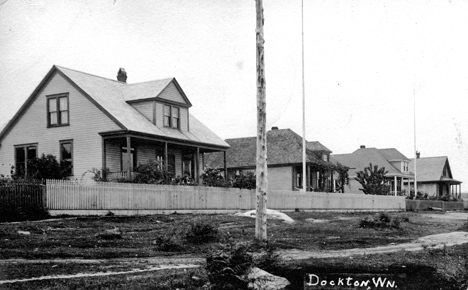In 1891, the largest dry dock on the West Coast was moved to what would later become Dockton.
The dry dock, which was 102 feet wide by 325 feet long, was built in Port Hadlock near Port Townsend and took more than two million board feet of lumber to construct. A dry dock was used to raise large vessels, such as the Mosquito Fleet steamers or ocean-going ships, out of the water so they could be repaired or their hulls cleaned.
The dry dock was originally intended for Port Townsend, but its builders had financial difficulties and sold it to the Griggs family of Tacoma, where it was towed. The dry dock’s large size was too much for the Tacoma Waterway, so the Griggs went into partnership with Miles Hatch, who owned property on Vashon, and they had it moved to the protected waters of Quartermaster Harbor.
The dry dock was installed in 1891 and was ready for operation in March 1892. Peter Manson, who noted that the newly installed facility “could dock a ton of boats,” named the village surrounding the dry dock Dockton.
Many of those who came to work in the dry dock and shipyards were from the Dalmation Coast of what was then the Austrian Empire and is today Croatia.
Dockton was often nicknamed “ichville” because of the prominence of Croatian names like Martinolich, Plancich, Kulusich and others.
To house the families of the supervisors of the dry dock, four houses were built between 1893 and1898 on the bluff above the dock’s location. These houses became known as Piano Row because they were the only houses in Dockton large enough to have pianos in their parlors and whose owners were affluent enough to afford them.
In 1909 the dry dock was sold and moved to Seattle, leaving behind the four houses and the village of Dockton, which continued to thrive for another 25 years, thanks to the presence of the Stuckey Shipyard, the Martinolich Shipyard, the Dockton Cannery, and the Dockton fishing fleet. These all declined with the cannery closing in the late 1910s, the shipyards closing in the late 1920s, and the fishing fleet, which still operates out of Dockton today, declining as the fishery was pushed north to Alaska as fish runs declined.
The original photograph is from the late 1890s and shows the four houses in their original condition with the picket fence and dirt roadway in front.
The current photograph taken in 2009 shows how remarkably little the houses have changed, at least on the outside. A modern asphalt road with the appropriate safety striping has replaced the dirt road. The sidewalk in front of the houses (the first concrete sidewalk on the Island) was built during the Great Depression of the 1930s by the Works Progress Administration under the direction of Theo Berry, the owner of the Dockton Store. The dormer on the second house was expanded, and additional dormers were added on the side and back. The trees and shrubs have grown and matured, but otherwise the houses remain much as they were in the 1890s.
— Bruce Haulman is an Island historian. Terry Donnelly is an Island photographer.



